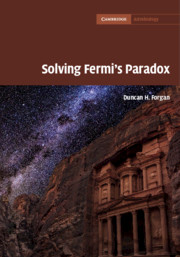Refine listing
Actions for selected content:
17001 results
20 - Probe Exploration Is Dangerous
- from Part IV - Uncommunicative Solutions
-
- Book:
- Solving Fermi's Paradox
- Published online:
- 25 April 2019
- Print publication:
- 02 May 2019, pp 282-290
-
- Chapter
- Export citation
23 - The Zoo/Interdict Hypothesis
- from Part IV - Uncommunicative Solutions
-
- Book:
- Solving Fermi's Paradox
- Published online:
- 25 April 2019
- Print publication:
- 02 May 2019, pp 326-329
-
- Chapter
- Export citation

Solving Fermi's Paradox
-
- Published online:
- 25 April 2019
- Print publication:
- 02 May 2019
11 - Luminous Blue Variables: Their Formation and Instability in the Context of Binary Interactions
-
- Book:
- The Impact of Binary Stars on Stellar Evolution
- Published online:
- 05 April 2019
- Print publication:
- 18 April 2019, pp 153-166
-
- Chapter
- Export citation
8 - The Importance of Binarity in the Formation and Evolution of Planetary Nebulae
-
- Book:
- The Impact of Binary Stars on Stellar Evolution
- Published online:
- 05 April 2019
- Print publication:
- 18 April 2019, pp 106-127
-
- Chapter
- Export citation
6 - The Symbiotic Stars
-
- Book:
- The Impact of Binary Stars on Stellar Evolution
- Published online:
- 05 April 2019
- Print publication:
- 18 April 2019, pp 77-91
-
- Chapter
- Export citation
1 - The Zoo of Binary Stars
-
- Book:
- The Impact of Binary Stars on Stellar Evolution
- Published online:
- 05 April 2019
- Print publication:
- 18 April 2019, pp 1-11
-
- Chapter
- Export citation
5 - Low- and Intermediate-Mass Star Evolution: Open Problems
-
- Book:
- The Impact of Binary Stars on Stellar Evolution
- Published online:
- 05 April 2019
- Print publication:
- 18 April 2019, pp 62-76
-
- Chapter
- Export citation
9 - Massive Star Evolution: Binaries as Two Single Stars
-
- Book:
- The Impact of Binary Stars on Stellar Evolution
- Published online:
- 05 April 2019
- Print publication:
- 18 April 2019, pp 128-143
-
- Chapter
- Export citation
Foreword
-
- Book:
- The Impact of Binary Stars on Stellar Evolution
- Published online:
- 05 April 2019
- Print publication:
- 18 April 2019, pp xix-xxii
-
- Chapter
- Export citation
15 - The Impact of Binaries on the Stellar Initial Mass Function
-
- Book:
- The Impact of Binary Stars on Stellar Evolution
- Published online:
- 05 April 2019
- Print publication:
- 18 April 2019, pp 208-224
-
- Chapter
- Export citation
19 - Clocks and Scales: Playing with the Physics of Blue Stragglers
-
- Book:
- The Impact of Binary Stars on Stellar Evolution
- Published online:
- 05 April 2019
- Print publication:
- 18 April 2019, pp 277-297
-
- Chapter
- Export citation
16 - The Formation of Binary Stars: Insights from Theory and Observation
-
- Book:
- The Impact of Binary Stars on Stellar Evolution
- Published online:
- 05 April 2019
- Print publication:
- 18 April 2019, pp 225-243
-
- Chapter
- Export citation
20 - Binaries at Very Low Metallicity
-
- Book:
- The Impact of Binary Stars on Stellar Evolution
- Published online:
- 05 April 2019
- Print publication:
- 18 April 2019, pp 298-306
-
- Chapter
- Export citation
Introduction
-
- Book:
- The Impact of Binary Stars on Stellar Evolution
- Published online:
- 05 April 2019
- Print publication:
- 18 April 2019, pp xxiii-xxiv
-
- Chapter
- Export citation
7 - Binary Post-AGB Stars as Tracers of Stellar Evolution
-
- Book:
- The Impact of Binary Stars on Stellar Evolution
- Published online:
- 05 April 2019
- Print publication:
- 18 April 2019, pp 92-105
-
- Chapter
- Export citation
Frontmatter
-
- Book:
- The Impact of Binary Stars on Stellar Evolution
- Published online:
- 05 April 2019
- Print publication:
- 18 April 2019, pp i-vi
-
- Chapter
- Export citation
13 - Binary Interactions and Gamma-Ray Bursts
-
- Book:
- The Impact of Binary Stars on Stellar Evolution
- Published online:
- 05 April 2019
- Print publication:
- 18 April 2019, pp 181-190
-
- Chapter
- Export citation
Index
-
- Book:
- The Impact of Binary Stars on Stellar Evolution
- Published online:
- 05 April 2019
- Print publication:
- 18 April 2019, pp 329-334
-
- Chapter
- Export citation
3 - Gaia and LSST: Their Importance in Binary Star Research
-
- Book:
- The Impact of Binary Stars on Stellar Evolution
- Published online:
- 05 April 2019
- Print publication:
- 18 April 2019, pp 32-44
-
- Chapter
- Export citation
